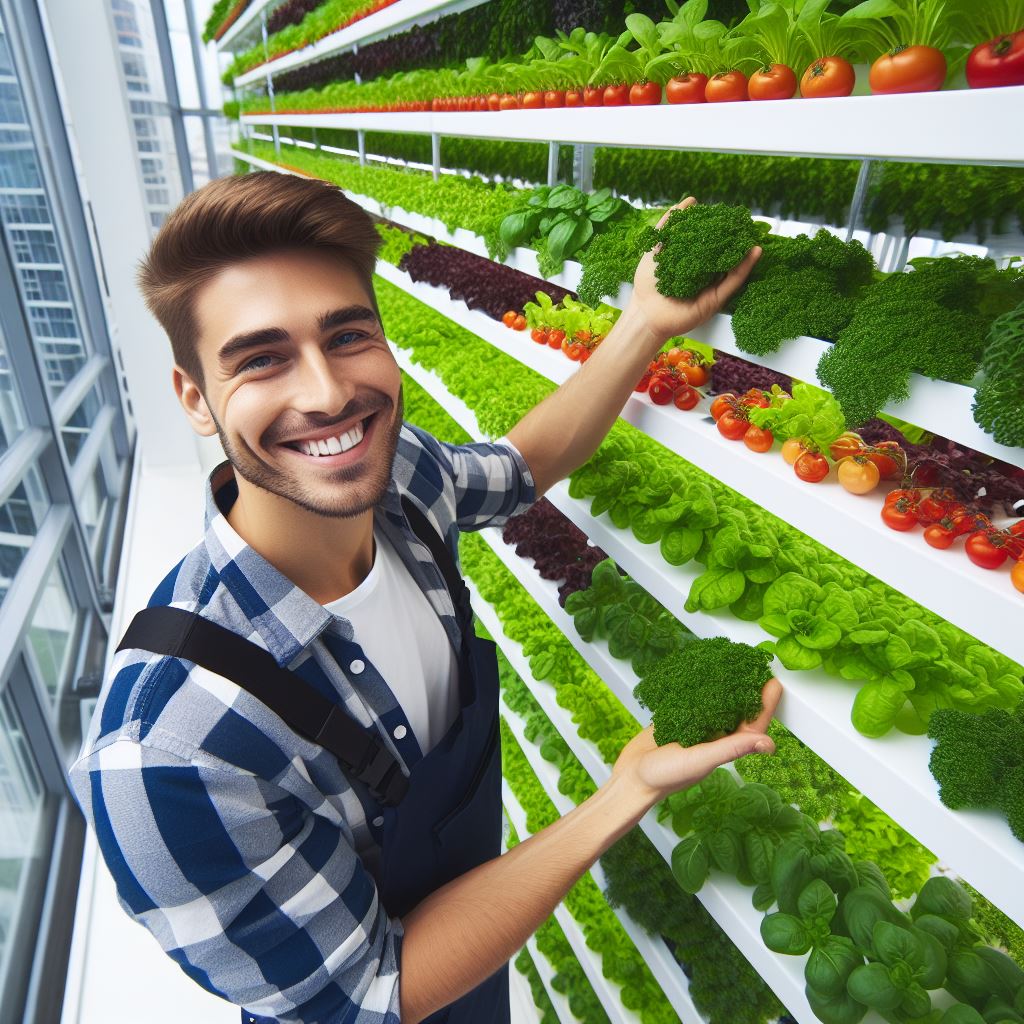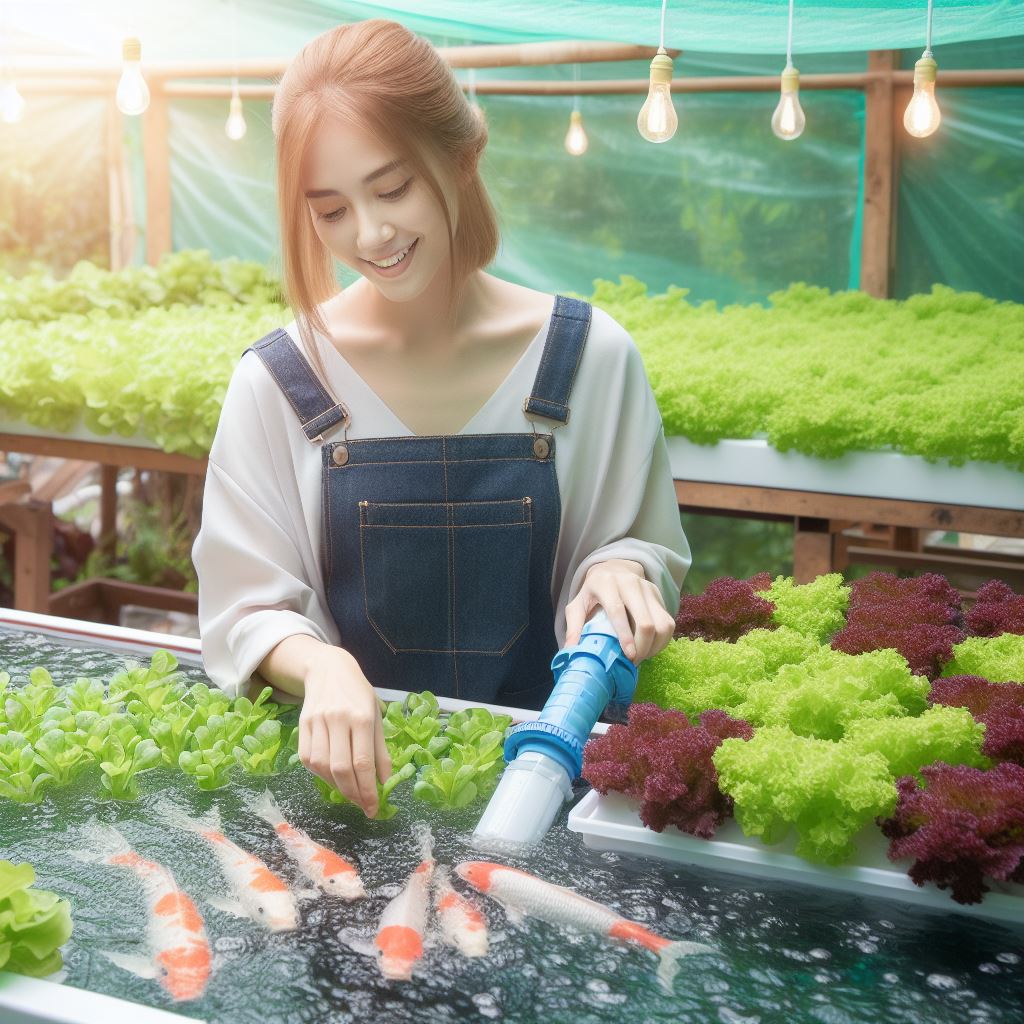Introduction
In today’s agricultural landscape, climate change poses unprecedented challenges.
Climate-smart farming emerges as a proactive approach to tackle these issues head-on.
It encompasses a holistic strategy that integrates sustainable practices to mitigate climate risks while improving productivity and resilience.
Adapting to climate change is not just a choice but a necessity for the agricultural sector.
With shifting weather patterns and unpredictable environmental conditions, traditional farming methods are becoming increasingly unsustainable.
Embracing climate-smart farming practices is crucial to ensure food security and livelihoods for future generations.
Technology serves as a powerful ally in the journey towards climate-smart agriculture.
From precision farming techniques to advanced data analytics, technological innovations enable farmers to optimize resource management, minimize environmental impact, and adapt to changing climate conditions effectively.
In this blog series, we will delve deeper into the principles of climate-smart farming, explore innovative technologies driving its adoption, and showcase real-world examples of its implementation.
Join us as we navigate the intersection of agriculture, climate change, and technology to cultivate a sustainable future for our planet.
Benefits of Climate-Smart Farming
Climate-smart farming refers to the implementation of innovative technologies and practices in agriculture that help farmers adapt to and mitigate the impacts of climate change.
This approach offers numerous benefits and opportunities for both farmers and the environment.
Increased productivity and efficiency
- Climate-smart farming practices, such as precision agriculture, can optimize the use of resources and improve crop yields.
- Advanced technologies like sensors and drones enable farmers to monitor crop health and apply inputs more precisely.
- Improved irrigation methods reduce water waste and ensure that crops receive the right amount of moisture.
Reduced environmental impact
- By adopting climate-smart practices, farmers can minimize greenhouse gas emissions and preserve natural resources.
- Promoting agroforestry and conservation tillage techniques helps sequester carbon dioxide and improve soil health.
- Efficient use of fertilizers and pesticides decreases pollution and protects biodiversity.
Improved resilience to climate variability
- Climate-smart farming equips farmers with tools to cope with extreme weather events and changing climatic patterns.
- By diversifying crops, farmers become less reliant on a single crop that may be vulnerable to climate shifts.
- Access to weather forecasting technologies helps farmers plan and adapt their farming practices accordingly.
Enhanced economic sustainability
- Adopting climate-smart farming practices can lead to increased profitability and overall economic stability.
- Efficiency improvements reduce production costs, resulting in higher incomes for farmers.
- By implementing sustainable practices, farmers have better access to markets demanding environmentally friendly products.
Examples and success stories
Several countries and organizations have already embraced climate-smart farming with impressive results:
- In Kenya, the adoption of climate-smart techniques increased maize yields by 30% and reduced water consumption.
- India’s System of Rice Intensification technique resulted in 22-66% higher rice yields while using 23-40% less water.
- In the United States, precision agriculture technologies have allowed farmers to reduce costs and optimize pesticide use.
- The Sustainable Rice Platform, implemented in multiple countries, has improved rice productivity while reducing environmental impact.
These success stories highlight the immense potential of climate-smart farming to address the challenges posed by climate change and create sustainable agricultural systems.
In fact, climate-smart farming offers a range of benefits, including increased productivity, reduced environmental impact, improved resilience, economic sustainability, and inspiring success stories.
Embracing innovative technologies and practices in agriculture is key to ensuring a resilient and sustainable future for farmers and the planet.
Read: Urban Farming: Challenges in the City
Technological Advancements in Climate-Smart Farming
Weather monitoring systems and prediction tools
The integration of weather monitoring systems and prediction tools has revolutionized climate-smart farming.
Farmers can now access real-time weather data and forecasts to make informed decisions.
These tools help them anticipate weather patterns, plan activities, and manage resources effectively.
With accurate weather predictions, farmers can reduce the risk of crop failure due to extreme weather events.
They can adjust their cultivation practices based on the forecasted conditions, maximizing yields and minimizing losses.
Smart irrigation systems
Smart irrigation systems have transformed the way water is used in agriculture.
Transform Your Agribusiness
Unlock your farm's potential with expert advice tailored to your needs. Get actionable steps that drive real results.
Get StartedThese systems utilize sensors and data analysis to determine the precise watering needs of crops.
Farmers can optimize irrigation schedules based on soil moisture levels and weather conditions.
This technology helps conserve water by preventing over-irrigation, reducing water waste, and improving water-use efficiency.
Smart irrigation systems also enable farmers to remotely control and monitor their irrigation systems, saving time and labor.
Precision farming and data-driven decision-making
Precision farming techniques combined with data-driven decision-making have enhanced productivity and sustainability.
Farmers can collect data through sensors, satellite imagery, and field mapping tools to analyze crop conditions.
By analyzing this data, they can make informed decisions regarding planting, fertilization, and pest control.
Precision farming allows farmers to apply inputs only where and when necessary, reducing waste and environmental impact.
Through data-driven decision-making, farmers can optimize resource allocation and improve overall farm management efficiency.
Crop and livestock disease monitoring and early detection
Technological advancements have led to improved monitoring and early detection of crop and livestock diseases.
Sensors and imaging techniques enable farmers to detect disease symptoms at an early stage.
Real-time monitoring systems alert farmers of any abnormal changes in crop or livestock health.
Early detection allows for timely intervention, preventing the spread of diseases and minimizing economic losses.
By monitoring disease patterns, farmers can also implement preventive measures, reducing the need for excessive pesticide or antibiotic use.
Remote sensing and drones for resource management
Remote sensing technologies and drones play a vital role in climate-smart farming for resource management.
Drones equipped with imaging sensors provide high-resolution aerial data for crop monitoring and analysis.
Remote sensing allows farmers to assess crop health, identify nutrient deficiencies, and detect pest infestations.
This technology enables targeted interventions, reducing the use of chemicals and improving resource efficiency.
By precisely mapping resource distribution, farmers can optimize fertilizer and pesticide application, minimizing waste and environmental impact.
Innovative farm management systems and applications
Innovative farm management systems and applications have simplified farm operations and increased productivity.
Mobile apps and online platforms allow farmers to access information, connect with experts, and manage farm activities.
These applications provide real-time data on market prices, weather conditions, and pest outbreaks.
Farmers can streamline their operations, track inventory, and optimize logistics through these systems.
Innovative technologies empower farmers with knowledge and tools to make better decisions and improve their farming practices.
Showcase Your Farming Business
Publish your professional farming services profile on our blog for a one-time fee of $200 and reach a dedicated audience of farmers and agribusiness owners.
Publish Your ProfileIn general, technological advancements have ushered in a new era of climate-smart farming.
Weather monitoring systems, smart irrigation, precision farming, disease monitoring, remote sensing, and innovative farm management systems are revolutionizing agriculture.
By harnessing these technologies, farmers can adapt to changing climatic conditions, improve resource management, and ensure sustainable agricultural practices.
Read: Market Woes: A Small Farmer’s Struggle

Challenges and Barriers to Implementing Technology in Climate-Smart Farming
Implementing technology in climate-smart farming presents several challenges and barriers that need to be addressed in order to ensure widespread adoption and success.
These challenges range from high costs to limited access, lack of awareness, technical difficulties, and privacy concerns.
High costs and affordability issues
One of the primary barriers to implementing technology in climate-smart farming is the high costs associated with acquiring and using these technologies.
Investing in advanced farming equipment, sensors, and data analytics tools can be financially burdensome for many farmers, especially small-scale and resource-constrained ones.
The ongoing maintenance and upgrading costs further add to the financial challenges.
Limited access to technology in rural areas
Rural areas often face limited access to technological infrastructure, such as reliable internet connectivity and electricity supply.
Without proper infrastructure, farmers may struggle to adopt and benefit from climate-smart farming technologies, as they require continuous connectivity for data transfer, monitoring, and control.
Lack of access further widens the digital divide between rural and urban farming communities.
Lack of awareness and knowledge among farmers
Many farmers, especially those in developing regions, may lack awareness and knowledge about the potential benefits and applications of climate-smart farming technologies.
They may not be aware of the available tools, their functionalities, and how they can be integrated into their existing farming practices.
This lack of awareness and knowledge hinders the adoption and effective utilization of technology.
Technical difficulties and learning curve
Implementing technology in climate-smart farming requires technical skills and knowledge, which may pose challenges for farmers who are not familiar with using digital devices and software.
The learning curve associated with adopting and operating these technologies can be steep, especially for older and less tech-savvy farmers.
It may require additional time, training, and support to overcome these technical difficulties.
Privacy and data security concerns
With the use of technology comes the concern for privacy and data security.
Farmers may be apprehensive about sharing their farming data, including yield information, weather data, and financial records, due to fears of data breaches and misuse.
Ensuring robust data security measures and transparent data governance frameworks is crucial to building trust and addressing these concerns.
In short, while technology holds great promise for climate-smart farming, there are several challenges and barriers that need to be overcome.
These include high costs, limited access in rural areas, lack of awareness and knowledge, technical difficulties, and privacy concerns.
Governments, agricultural organizations, and technology providers need to collaborate and address these challenges to enable widespread adoption and successful implementation of technology in climate-smart farming.
Read: From Plows to iPads: A Farmer’s Tech Leap
See Related Content: Eco-Warrior Farmers: Youth Leading Change
Examples of Climate-Smart Farming Technologies
Case studies of successful technology adoption
In recent years, there have been several successful case studies showcasing the adoption of climate-smart farming technologies.
One such example is the use of precision agriculture techniques.
Precision agriculture involves the use of sensors, drones, and GPS technology to monitor and manage resources in real-time.
Farmers can collect data on soil moisture levels, crop health, and pest infestations, allowing them to make informed decisions.
For instance, in California, a grape grower implemented precision agriculture techniques by installing soil moisture sensors throughout the vineyard.
This enabled the farmer to optimize irrigation, reducing water usage by 20% while maintaining crop quality.
Another successful technology adoption case involves the use of hydroponics in urban farming. Hydroponics is a soilless growing method that delivers water and nutrients directly to plant roots.
This technology allows farmers to maximize space and resources, making it an ideal solution for urban areas with limited land availability.
In Tokyo, Japan, a vertical farm implemented hydroponics to grow lettuce in stacked layers.
The farm utilized LED lighting, which mimics natural sunlight, to provide the necessary light spectrum for photosynthesis.
As a result, the farm achieved higher crop yields, reduced water consumption by 90%, and eliminated the need for pesticides.
Impact of technology on different types of farming (e.g., crop, livestock, aquaculture)
The impact of technology on different types of farming, be it crop, livestock, or aquaculture, has been significant.
Technological advancements have revolutionized these sectors by improving efficiency, productivity, and sustainability.
In crop farming, technologies such as precision agriculture, automated irrigation systems, and genetically modified crops have helped farmers increase yields while minimizing inputs.
Crop monitoring systems that utilize satellite imagery can identify crop stress early on, allowing prompt intervention and preventing yield loss.
Livestock farming has also benefitted from technology.
The use of wearable sensors can continuously monitor the health and behavior of animals, detecting issues like disease outbreaks or calving difficulties.
These sensors provide real-time data, enabling farmers to provide targeted care and improve overall herd management.
In aquaculture, technological advancements have led to the development of recirculating aquaculture systems (RAS). RAS utilize water filtration and monitoring systems, resulting in reduced water usage and waste discharge.
This technology has improved water quality, disease control, and overall production efficiency in fish farming.
Government initiatives and support for technological advancements
To promote technological advancements in climate-smart farming, governments have initiated various programs and provided support to farmers.
For example, the United States Department of Agriculture (USDA) has established the Conservation Innovation Grants (CIG) program.
CIG provides funding to farmers and organizations to develop and implement innovative technologies and approaches that conserve natural resources.
The European Union (EU) has also taken steps to support technological advancements in agriculture.
Through its Common Agricultural Policy (CAP), the EU offers financial incentives to farmers who adopt sustainable farming practices and invest in climate-smart technologies.
Additionally, many governments have launched extension services and training programs to educate farmers about the benefits of adopting climate-smart farming technologies.
These initiatives aim to bridge the knowledge gap and facilitate the adoption of innovative practices.
By supporting technological advancements in agriculture, governments can help farmers adapt to climate change, enhance food security, and contribute to sustainable development.
Examples of successful technology adoption in climate-smart farming, the impact on different farming types, and government support demonstrate the importance of utilizing innovative solutions to address the challenges of a changing climate.
Read: Precision Agriculture: My Farm’s Success Story
Future Prospects and Potential of Climate-Smart Farming Technology
Emerging trends and innovations
- Continuous advancements in technology are revolutionizing the agriculture sector.
- Climate-smart farming technology is an emerging trend that offers sustainable solutions.
- Farmers are adopting innovative techniques to optimize crop production and reduce environmental impact.
- Smart sensors and drones are being used to monitor soil conditions and crop health.
- New irrigation systems and drought-resistant crop varieties are being developed to mitigate climate change effects.
Integration of artificial intelligence and machine learning
- Artificial intelligence (AI) and machine learning (ML) are transforming agriculture.
- AI-powered weather forecasting models help farmers make informed decisions.
- ML algorithms analyze data to optimize irrigation, fertilization, and pest control.
- This integration enhances productivity, reduces costs, and minimizes resource wastage.
- AI can also assist in early pest detection and prevent significant crop losses.
Automation and robotics in agriculture
- Automation and robotics are playing a significant role in climate-smart farming.
- Robots can perform tasks like planting, harvesting, and sorting with precision and efficiency.
- Automated systems help reduce labor requirements, increase productivity, and improve crop quality.
- Robotic sensors enable real-time data collection, optimizing resource utilization.
- Drones equipped with infrared cameras can identify stressed crops for targeted interventions.
Global collaborations and partnerships for technology development
- To harness the full potential of climate-smart farming technology, global collaborations and partnerships are essential.
- Sharing knowledge and best practices can accelerate technology development and adoption.
- International organizations are supporting research and development programs in climate-smart agriculture.
- Public-private partnerships are fostering innovation and commercialization of climate-smart farming solutions.
- The exchange of expertise and resources is vital for addressing global food security challenges.
In essence, climate-smart farming technology holds immense future prospects and potential.
Emerging trends and innovations, such as smart sensors, drones, and drought-resistant crop varieties, are enabling farmers to adapt to changing climates.
The integration of artificial intelligence and machine learning is optimizing agricultural practices and improving productivity.
Automation and robotics are transforming farming operations, reducing labor requirements, and maximizing resource utilization.
Global collaborations and partnerships are crucial for technology development and widespread adoption.
By embracing climate-smart farming technology, we can create a sustainable and resilient agricultural system to ensure food security for future generations.
Conclusion
Climate-smart farming is of utmost importance in today’s changing climate.
By utilizing technology, farmers can effectively adapt and mitigate the impacts of climate change.
It is crucial for farmers to embrace climate-smart farming practices and utilize technology to their advantage.
Through the implementation of advanced technologies, farmers can increase resilience and improve agricultural productivity.
Climate-smart farming practices, such as precision agriculture and data-driven decision making, can optimize resource use.
By embracing technology, farmers can reduce greenhouse gas emissions, conserve water, and protect their livelihoods.
Technology enables farmers to monitor weather patterns, predict risks, and respond proactively.
With the help of technology, farmers can adapt to the changing climate and secure sustainable food production for the future.
In order to ensure long-term agricultural sustainability, it is imperative for farmers to adopt climate-smart farming practices.
Showcase Your Farming Business
Publish your professional farming services profile on our blog for a one-time fee of $200 and reach a dedicated audience of farmers and agribusiness owners.
Publish Your ProfileWith continuous innovation and collaboration between farmers and technology providers, the agricultural sector can effectively mitigate climate change impacts.
Let us embrace climate-smart farming and leverage technology to create a resilient and sustainable future for agriculture.




